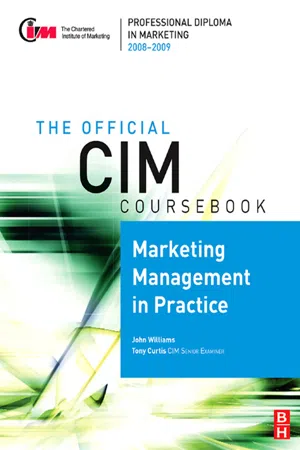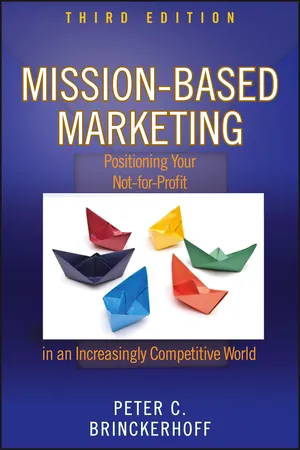Marketing Plan
A marketing plan is a comprehensive document that outlines an organization's overall marketing efforts. It typically includes an analysis of the market, target audience, marketing goals, strategies, tactics, and budget. The plan serves as a roadmap for the marketing team to follow in order to achieve the company's objectives.
8 Key excerpts on "Marketing Plan"
- Bonita M. Kolb(Author)
- 2016(Publication Date)
- Routledge(Publisher)
...The organization may have ideas for new products, new locations, new audiences, and new promotion. While they may all be good ideas, they will all take time, money, and people to implement. A plan with too many goals will be unsuccessful because the available organizational resources are spread too thinly for successful implementation. Writing a Marketing Plan will force the organization to choose only one or, at most, two goals for which they have the resources of time, people, and money so as to ensure the goal is achieved. The chosen ideas will be expressed as marketing goals and objectives. Additional ideas can be saved for future Marketing Plans. Purpose of the plan—a roadmap plus accountability leads to success Once the organization has decided on a course of action, a well written, detailed Marketing Plan keeps everyone moving together toward the same goal. People will understand what actions must be taken in what order. In addition, people will understand which tasks they have been assigned to complete. A marketing strategy that starts with producing the product and ends with the product in the home of a satisfied customer is a process that includes many steps. It may be that only those responsible for the Marketing Plan are able to understand the entire process, but the plan will keep everyone else in the organization on the task. One of the key benefits of a Marketing Plan is that it provides for accountability and reduces duplication. Everyone knows the tasks that each of them must perform each day. To ensure success, the tasks are being given to those with the necessary skills. In addition, to ensure success, the tasks are tracked; so if they are not completed, the marketing department will be able to remedy the situation. This does not mean that the marketing department should approach the process in a dictatorial fashion. Such an approach almost guarantees that people will not cooperate...
- Bonita Kolb(Author)
- 2020(Publication Date)
- Routledge(Publisher)
...While the organization may have a vague idea such as people who love music, the Marketing Plan will force them to develop a clear description including demographic facts, psychographic characteristics, and geographic location. Finally, writing the Marketing Plan will force the organization to answer questions about their competitors. As customers will certainly compare products, the organization must do so also. To answer all of these questions, research may be required. One of the mistakes made by many small businesses is to try to do too much with too little. The organization may have ideas for new products, new locations, new audiences, and new promotion. While they may all be good ideas, they will all take time, money, and people to implement. A plan with too many goals will be unsuccessful because the available organizational resources are spread too thinly for successful implementation. Writing a Marketing Plan will force the organization to choose only one or, at most, two goals for which they have the resources of time, people, and money so as to ensure the goal is achieved. The chosen ideas will be expressed as marketing goals and objectives. Additional ideas can be saved for future Marketing Plans. Purpose of the plan—a roadmap plus accountability leads to success Once the organization has decided on a course of action, a well written, detailed Marketing Plan keeps everyone moving together toward the same goal. People will understand what actions must be taken in what order. In addition, people will understand which tasks they have been assigned to complete. A marketing strategy that starts with producing the product and ends with the product in the home of a satisfied customer is a process that includes many steps...
- William Winston(Author)
- 2012(Publication Date)
- Routledge(Publisher)
...Chapter 2 Introduction to Marketing Planning WHAT IS A Marketing Plan? A Marketing Plan is a framework which lays out the specific steps for marketing the health organization. Marketing Plans have become indispensable in health facilities that want to successfully compete in today's marketplace. Before being able to commit marketing resources in the most effective and efficient way, a systematic approach to marketing needs to be established. This systematic process will be organized in the form of a formal Marketing Plan. No marketing activities should be initiated without a plan. Unfortunately, the use in health and human services of the formal Marketing Plan is still relatively rare. In most health organizations marketing tends to be implemented on a piecemeal basis and is concentrated on public relations, advertising, and most recently, contracting. These health organizations rely on separate programs and plans whose coordination is often haphazard rather than synergistic. The Marketing Plan specifies by service who will do what, where, when, and how, to accomplish the organization's goals in the most efficient method. The plan is a schedule of events and activities of a preplanned marketing effort...
- eBook - ePub
- Jeffrey H. Rattiner(Author)
- 2010(Publication Date)
- Bloomberg Press(Publisher)
...If the incoming call rate is increasing each month and positive blips occur around the time of a promotional event—usually within thirty to sixty days—then you are getting the combined benefit of word of mouth and marketing. • Increasing retention. One can argue that client retention is a function of the quality, value, and ongoing care you provide to your clients. However, client retention is also a function of your ability to design and communicate new products and services. The speed with which new products and services are adopted by clients is a measure of your marketing acumen. What Is a Marketing Plan? MARKETING Is the process of finding and creating customers for your products and services. Sales is the process of transforming an interested prospect into a committed client. Your Marketing Plan is a written document that describes your targets, your message, the ways you plan to communicate your message, the costs involved, and the expected results. In essence, a Marketing Plan is a road map that helps you figure out the best way to reach your clientele. It helps you to understand your business thoroughly by requiring you to think and write about how to differentiate your services. If your message is not clear and different from the competition, no amount of hard work will yield increasing prices, margin per client, referrals, and retention. A Marketing Plan should be easy to comprehend, easy to follow, and based on a logical sequence of steps. Almost anyone—prospect or friend—should be able to understand, recite, and follow your plan. Ask your advisory board to add a professional touch to any rough edges or to mention opportunities you may have overlooked. Elements of a Marketing Plan YOUR Marketing Plan will be a subsection of your overall business plan (see Chapter 6)...
- Tony Curtis, John Williams(Authors)
- 2012(Publication Date)
- Routledge(Publisher)
...If it can gain a decisive edge in one key function, it will eventually be able to improve its other functions. 2 Customer-based strategies : Clients are the basis of any strategy. In the long run, the corporation that is genuinely interested in its customers will be interesting for its investors. 3 Competitor-based strategies : These can be constructed by looking at possible sources of differentiation in functions such as: purchasing, design, engineering, sales and servicing. Ohmae, K. (1991) The Mind of the Strategist: The Art of Japanese Business, McGraw-Hill Marketing Plan Components The following are examples of what can be included in a Marketing Plan but it does not necessarily follow that every plan will have all of these components. Marketing Plans tend to vary by industry, size of company, stage of growth and organizational goals. The process of preparing it is as important as the particular form it takes. The process should make you think about goals and the marketing strategy that will be used to achieve them. A Marketing Plan may contain all or just some of the following components. Executive Summary Introducing the organization: Explain the major points of your plan Describe briefly the nature of the business and the products or services offered Include a mission or values statement and objectives List the structure of your organization and the senior management team Summarize the marketing objectives and strategies that are in the plan. Marketing Audit A good marketing audit is: Systematic – It follows a logical, predetermined framework, an orderly sequence of diagnostic steps. Comprehensive – It considers all factors affecting marketing performance, not just obvious trouble spots. Marketers can be fooled into addressing symptoms rather than underlying problems. A comprehensive audit can identify the real problems. Independent – To ensure objectivity, outside consultants are sometimes used to prepare the marketing audit...
- eBook - ePub
Strategic Marketing
An Introduction
- Tony Proctor(Author)
- 2002(Publication Date)
- Routledge(Publisher)
...In this next stage, each marketing strategy element has now to be elaborated to show: • what will be done • when it will be done • who will do it • how much it will cost. 7 Projections of profits and losses The action plan will enable the marketing manager to develop a budget requirement. On the revenue side it will show predicted sales volume in units and the average realized price. On the expense side, it will show production costs, physical distribution costs and other marketing costs broken down into fine detail. It will also show the projected profit based on these figures. 8 Controls The final section of the planning document should outline the nature of the controls to be employed in monitoring the progress of the plan when it is put into operation. This section of the plan might also contain contingency plans. Such plans would outline what action would be required as a response to specific adverse developments which might have a profound effect on the achievement of what has been set out in the budget. EXHIBIT 14.3 Marketing Plan OUTLINE—AN ALTERNATIVE 1 Overview A brief description of the assumptions of the plan, its goals and the major actions to be taken. This should be short and to the point. Its purpose is to give the reader a quick snapshot of the plan, whether they are reading it for the first time or re- reading it to assess progress. Anyone must be able to understand the plan from reading the overview. 2 Background or Situation Analysis Those points of information that are the foundation for any action recommended. They might include: Corporate goals, consumer or customer information, demographics, psychographics, economic factors and trends, product facts, company capabilities and limitations, competitive assessments, projections, personnel issues, research findings, etc...
- eBook - ePub
- Jim Blythe(Author)
- 2012(Publication Date)
- Routledge(Publisher)
...You should be specific in what you are telling people to do – if you are asked for recommendations, say something that people can act on. STAGES OF THE PLANNING PROCESS Planning goes through distinct stages, as follows: Corporate objectives are set. These are the overall strategic objectives set by the directors of the firm. They may or may not be customer oriented, depending on the orientation of the firm, but almost all corporate objectives will rely on marketing to a greater or lesser extent. The corporate objectives may be very long term or relatively short term. Marketing audit. This is a snapshot of the company’s current situation: there is more on this later in the module. Essentially, it covers everything the marketing managers need to know about the firm’s internal and external environments, including competitors, customers, available resources and current activities and commitments. The marketing audit enables the planners to understand where the company is now, an important piece of information when deciding how to get to where we want to be. Setting business and marketing objectives. These objectives are set in terms of meeting the overall corporate objectives, so they might be seen as sub-objectives (i.e. tactical rather than strategic). This breaks down the overall objectives into manageable chunks for each department to handle. Marketing strategies. Strategy is about where we are going rather than about how we get there. Strategy is therefore concerned with determining where we should be as a firm and is usually (though not always) considered in terms of competitive position...
- eBook - ePub
Mission-Based Marketing
Positioning Your Not-for-Profit in an Increasingly Competitive World
- Peter C. Brinckerhoff(Author)
- 2010(Publication Date)
- Wiley(Publisher)
...CHAPTER 12 A Marketing Planning Process Chapter Thumbnail Developing Your Marketing Team An Asking Schedule Targeting Your Marketing Effort A Marketing Plan Outline Marketing Planning Software Overview Now we need to put it all together. You have all the philosophical and technical information you need to move your organization toward becoming market driven and mission based. But to get from where you are to where you want to go, you need a plan. Recall that earlier I said that you needed to improve, to change incrementally—1 percent at a time. I also noted that if those 1 percent changes were not directed by a plan, they could just result in your going in circles. It has been said that, without a plan, the only way you get where you are going is by accident. I agree; you certainly don’t want to have the results of all your marketing efforts be haphazard or accidental. You don’t want to have one part of your organization target one group of people and ignore another, especially if that second group is the target market for a different part of your organization. You don’t want to have multiple “identities” to the public, nor do you want to survey the same part of your market five times, and another not at all. Good Marketing Planning should allow you to do all the things that you need to in a coordinated, efficient, and effective manner. This chapter will show you how to begin the planning process. We will start at the beginning, putting together a winning marketing team. I’ll make some suggestions on whom to pick, how to put the group together, and what their job descriptions should be. Next, we’ll examine how to develop an asking schedule. Recall that in Chapter 8, on asking, I noted that among the mistakes people make is asking either too often or too infrequently. This schedule will help you avoid that. But how do you choose which market to ask and when? I’ll show you...







